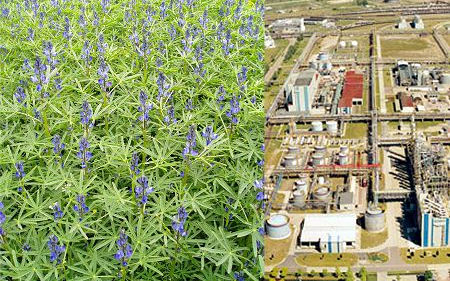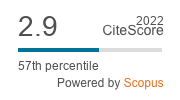Biorefineries: Relocating Biomass Refineries to the Rural Area
DOI:
https://doi.org/10.3097/LO.201227Keywords:
Biorefinery, Raw material assessment, Rural areas, Sustainable developmentAbstract
The field for application of biomass is rising. The demand for food and feeding stuff rises while at the same time energy, chemicals and other materials also need to be produced from biomass because of decreasing fossil resources. However, the biorefinery ideas and concepts can help to use the limited renewable raw materials more efficiently than today. With biorefineries, valuable products, such as platform chemicals, can be produced from agricultural feedstock, which can subsequently be further processed into a variety of substances by the chemical industry. Due to the role they play as producers of biomass, rural areas will grow in importance in the decades to come. Parts of the biorefinery process can be relocated to the rural areas to bring a high added value to these regions. By refining biomass at the place of production, new economic opportunities may arise for agriculturists, and the industry gets high-grade pre-products. Additionally, an on-farm refining can increase the quality of the products because of the instant processing. To reduce competition with the food production and to find new possibilities of utilisation for these habitats, the focus for new agricultural biomass should be on grasslands. But also croplands can provide more renewable raw materials without endangering a sustainable agriculture, e.g. by implementing legumes in the crop rotation. To decide if a region can provide adequate amounts of raw material for a biorefinery, new raw material assessment procedures have to be developed. In doing so, involvement of farmers is inevitable to generate a reliable study of the biomass refinery potentials.
References
Deutscher bundestag. (2009). Gesetz Für Den Vorrang Erneuerbarer Energien(Erneuerbare-Energien-Gesetz - EEG), , 35.
Landwirtschaft und verbraucherschutz & bundesministerium für umwelt, naturschutz und reaktorsicherheit. (2009). Nationaler Biomasseaktionsplan Für Deutschland: Beitrag Der Biomasse Für Eine Nachhaltige Energieversorgung, , 30.
Naturschutz und reaktorsicherheit. (2007). Nationale Strategie Zur Biologischen Vielfalt, , 178.
Arthurson, V. (2009). Closing the global energy and nutrient cycles through application of biogas residue to agricultural land - potential benefits and drawbacks. Energies, 2(2), 226-242. doi:10.3390/en20200226
Aufhammer, W. (1998). Getreide- Und Andere Körnerfruchtarten: Bedeutung, Nutzung Und Anbau,
Boelcke, B. (2004). (Landesforschungsanstalt für landwirtschaft und fischerei mecklenburg-vorpommern). Stoffstromanalyse Zur Nachhaltigen Energetischen Nutzung Von Biomasse, , 263.
Bonk, M. (1999). Chancen für die nutzung pflanzlicher proteine. Naturw Rdsch, , 485-489.
Carolan, J. E., Joshi, S. V., & Dale, B. E. (2007). Technical and financial feasibility analysis of distributed bioprocessing using regional biomass pre-processing centers. Journal of Agricultural and Food Industrial Organization, 5(2) doi:10.2202/1542-0485.1203
Edwards, R. H., Miller, R. E., de Fremery, D., Knuckles, B. E., Bickoff, E. M., & Kohler, G. O. (1975). Pilot plant production of an edible white fraction leaf protein concentrate from alfalfa. Journal of Agricultural and Food Chemistry, 23(4), 620-626. doi:10.1021/jf60200a046
Ernährung, B. F., & Verbraucherschutz, L. U. (2009). Aktionsplan Der Bundesregierung Zur Stofflichen Nutzung Nachwachsender Rohstoffe,
Freyer, B. (2003). Fruchtfolgen - konventionel integriert biologisch. eugen ulmer GmbH & co. Anforderungen an Die Landwirtschaftliche Grünlandnutzung in Brandenburg, , 12.
Helming, K., Pérez-Soba, M., & Tabbush, P. (2008). Sustainability impact assessment of land use changes. Sustainability impact assessment of land use changes (pp. 1-507) doi:10.1007/978-3-540-78648-1
Kahnt, G. (2008). Leguminosen Im Konventionellen Und Ökologischen Landbau,
Kamm, B., & Kamm, M. (2007). Das konzept der bioraffinerie - produktion von plattformchemikalien und finalprodukten. Chemie-Ingenieur-Technik, 79(5), 592-603. doi:10.1002/cite.200700005
Krotscheck, C., Kromus, S., Hong Tang, Y., & Koschuh, W. (2004). Grüne bioraffinerie - gewinnung von milchsäure aus grassilagesaft. Berichte Aus Energie-Und Umweltforschung, , 219.
Leiß, S., Venus, J., & Kamm, B. (2010). Fermentative Herstellung Von L-Lysin-L-Lactat Mittels Fraktionierungssäften Aus Der Grünen Bioraffinerie, , 82.
Papendiek, F. (2010). Bioraffinerien: Die Stoffliche Nutzung Nachwachsender Rohstoffe Und Die Verlagerung Ihrer Veredelung in Den Ländlichen Raum, , 1-105.
Papendiek, F., Ende, H. P., Steinhardt, U., & Wiggering, H. (2011). Erschließung neuer rohstoffpotenziale durch komplexe bioraffinerien. Archiv Für Forstwesen Und Landschaftsökologie, 2, 82-88.
Peters, D., Holst, N., Hermann, B., Lulies, S., & Stolte, H. (2010). Nachwachsende Rohstoffe in Der Industrie,
Schönicke, P. (2010). BIOPOS Forschungsinstitut Bioaktive Polymersysteme 2010,
Thomsen, M. H., Bech, D., & Kiel, P. (2004). Manufacturing of stabilised brown juice for L-lysine production - from university lab scale over pilot scale to industrial production. Chemical and Biochemical Engineering Quarterly, 18(1), 37-46.
Van Ree, R., & Annevelink, B. (2007). Status report biorefinery 2007. Status Report Biorefinery 2007,
Venus, J. (2010). Leibniz- Institut Für Agrartechnik Potsdam-Bornim (ATB) e V,
Venus, J. (2006). Utilization of renewables for lactic acid fermentation. Biotechnology Journal, 1(12), 1428-1432. doi:10.1002/biot.200600180
Wragge, V., Sensel, K., & Nielsen, K. (2010). Kohlenstoffdynamik in gärprodukten aus biogasanlagen der nass- und trockenfermentation. Mitteilungen Der Gesellschaft Für Pflanzenbauwissenschaften, 22, 61-62.

Downloads
Published
How to Cite
Issue
Section
License
Copyright (c) 2019 Franka Papendiek, Hans-Peter Ende, Uta Steinhardt, Huber Wiggering

This work is licensed under a Creative Commons Attribution 4.0 International License.










